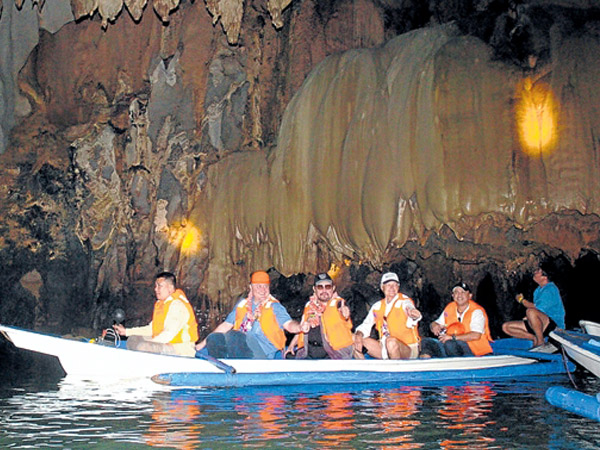 The Puerto Princesa Subterranean River National Park is situated around 50 km north of the city of Puerto Princesa, Palawan, Philippines. It includes a limestone karst mountain scene with a 8.2 km. safe underground waterway. A recognizing highlight of the waterway is that it winds through a hole before streaming specifically into the South China Sea. It incorporates real developments of stalactites and stalagmites, and a few vast chambers. The lower part of the waterway is liable to tidal impacts. The underground waterway is rumored to be the world's longest. At the mouth of the cavern, an unmistakable tidal pond is confined by old trees developing right to the water's edge. Monkeys, huge screen reptiles, and squirrels discover their specialty on the shoreline close to the hole.
The Puerto Princesa Subterranean River National Park is situated around 50 km north of the city of Puerto Princesa, Palawan, Philippines. It includes a limestone karst mountain scene with a 8.2 km. safe underground waterway. A recognizing highlight of the waterway is that it winds through a hole before streaming specifically into the South China Sea. It incorporates real developments of stalactites and stalagmites, and a few vast chambers. The lower part of the waterway is liable to tidal impacts. The underground waterway is rumored to be the world's longest. At the mouth of the cavern, an unmistakable tidal pond is confined by old trees developing right to the water's edge. Monkeys, huge screen reptiles, and squirrels discover their specialty on the shoreline close to the hole. The Puerto Princesa Subterranean River National Park is a secured range of the Philippines situated around 80 kilometers (50 mi) north of the downtown area of Puerto Princesa, Palawan. The waterway is additionally called Puerto Princesa Underground River. The national park is situated in the Saint Paul Mountain Range on the western shore of the island. It is circumscribed by St. Paul Bay toward the north and the Babuyan River toward the east. The City Government of Puerto Princesa has dealt with the National Park subsequent to 1992. The passage to the underground waterway is a short trek or vessel ride from the town Sabang.
In 2010, a gathering of earthy people and geologists found that the underground stream has a second floor, which implies that there are little waterfalls inside the hole. They likewise found a hole arch measuring 300 m (980 ft) over the underground stream, rock arrangements, extensive bats, a profound water gap in the waterway, more stream channels, and another profound hollow, and also marine animals and the sky is the limit from there. More profound territories of the underground waterway are practically difficult to investigate because of oxygen hardship.
On November 11, 2011, Puerto Princesa Underground River was temporarily picked as one of the New7Wonders of Nature. This determination was authoritatively affirmed on January 28, 2012.
The recreation center has a limestone karst mountain scene. St. Pauls Underground River Cave is more than 24 km (15 mi) long and contains a 8.2 km (5.1 mi) long underground area of the Cabayugan River. The waterway winds through the hollow before streaming straightforwardly into the West Philippine Sea and is safe by watercraft up to 4.3 km (2.7 mi) in from the ocean. The hole incorporates real developments of stalactites and stalagmites, and a few extensive chambers, including the 360-meter-long Italian's Chamber with rough 2.5 million square meters volume. It is one of the biggest hollow rooms on the planet. The lower bit of the waterway up to 6 km from the ocean, is liable to tidal impacts. Until the 2007 revelation of an underground waterway in Mexico's Yucatán Peninsula, the Puerto Princesa Subterranean River was rumored to be the world's longest underground stream.
The range likewise speaks to an environment for biodiversity protection. The site contains a full mountain-to-the-ocean biological system and has probably the most essential timberlands in Asia. It was engraved by UNESCO as a World Heritage Site on December 4, 1999.

